The Definitive Guide on Tennis Grips
A very important aspect of tennis is knowing what the tennis grips are and what they are used for. A tennis grip is essentially how you hold the racquet, with different types of tennis grips being used for different types of shots.
The three main types of tennis grips are:
- the Continental,
- the Eastern,
- and the Western,
- with a slight variation of the Western grip called the Semi-Western grip.
So, in this article, we will be going through the most popular tennis grips as well as how to tell what kind of grip you are using at any time.
Understanding the Tennis Grips
At first glance of a tennis racquet’s handle, you might notice that it has an octagonal shape. This is standard for all tennis racquets as it provides both comfort as well as enough friction to grip it, so get used to it! Being that it has an octagonal shape, the sides are referred to as bevels, which will help you determine the type of grip you are using depending on which bevels your fingers are placed on. The type of grip will depend on which bevel the index knuckle and heel pad lie on.
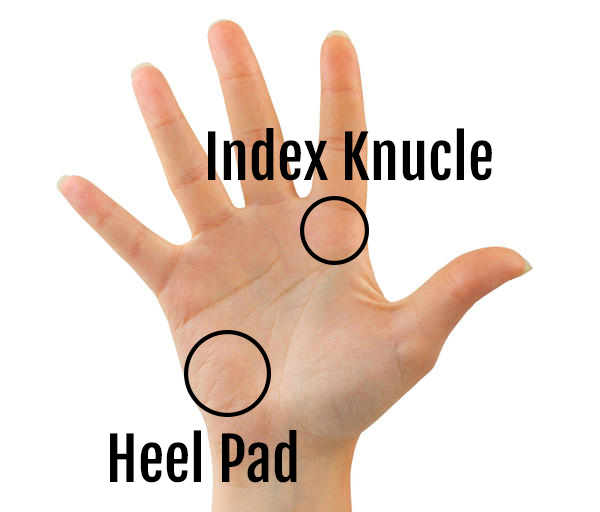
Index knuckle and heel pad of a right-handed player
The bevels are numbered 1 through 8 going clockwise for right-handed players while they run counterclockwise for left-handed players. Bevel #1 will be the bevel facing up if you were to hold the blade of the racquet perpendicular to the ground. Keep this in mind as we continue onto the different types of tennis grips.
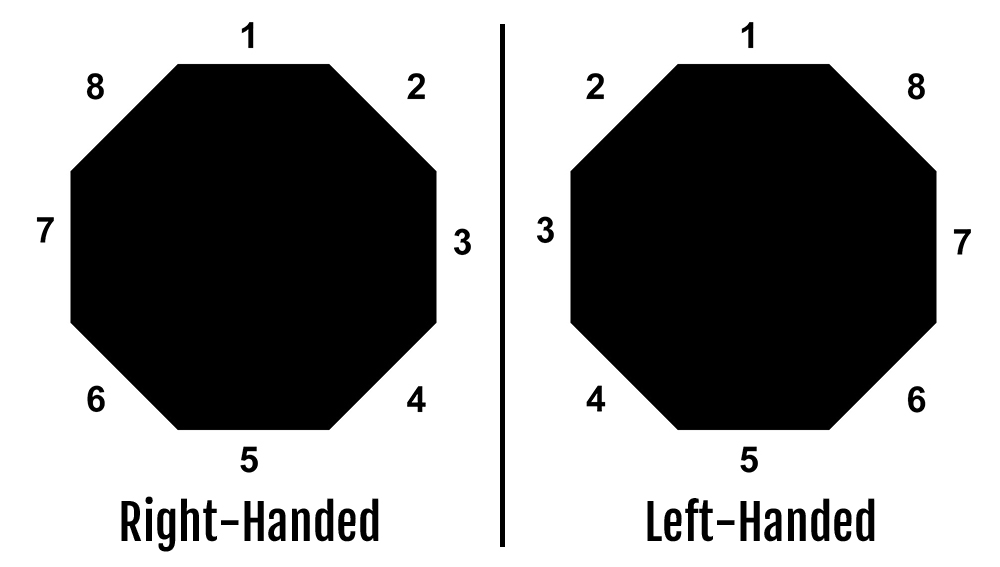
Types of Tennis Grips
**Refer to our glossary of tennis terms if you find any words you don’t understand**
Continental Grip
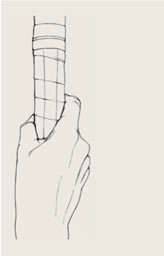
Index knuckle and heel pad on bevel 2
The Continental grip (also called the Chopper grip or Hammer grip) is a special grip reserved especially for serves, volleys, overheads, slices, and some defensive shots.
In order to use a Continental grip, your index knuckle and heel pad will rest on bevel #2. You will know if you have it right if your thumb and forefinger form a V across the top of the handle.
Advantages:
- Standard grip for serves and overheads, as it allows for you to naturally bend your wrist inward after performing these shots. This results in more power and less stress on your arm.
- Preferred grip for volleys, as an open racquet face delivers both underspin and control
- Using the Continental grip for both forehand and backhand volleys allow for quick shots while at net
- Can be used for defensive shots such as drop shots or wide balls
Disadvantages:
- Hard to put topspin on the ball if using a Continental grip for forehand shots
- Lack of consistency
Eastern Forehand Grip
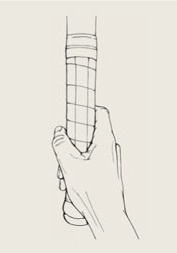
Index knuckle and heel pad on bevel 3
The Eastern forehand grip is primarily used for fast, flat shots. Can also be changed quickly from the Eastern forehand to the Continental grip for volleys. Shots using this type of grip will naturally be made at about waist level.
To achieve a proper Eastern forehand grip, you will need both your index knuckle and heel pad to rest on bevel #3. You can also place your hand flat against the strings and slide down to the handle to achieve an Eastern forehand.
Advantages:
- One of the easiest grips for learning forehand
- Easy to change from an Eastern forehand to a Continental
- Great for players who enjoy attacking the net
- Some topspin
Disadvantages:
- Little control over high balls
- Not enough control for long rallies
Eastern Backhand Grip
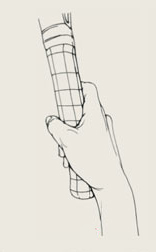
Index knuckle and heel pad on bevel 1
The Eastern backhand grip provides both spin and control for a one-handed backhand, and can be even more versatile if you use a Western forehand grip, which uses the same grip.
For an Eastern backhand grip, place your index knuckle and heel pad on bevel #1.
Advantages:
- Provides lots of control and ability to put spin on the ball
- Easy to change from an Eastern backhand to a Continental grip for players who enjoy playing at net
- Can also be used for a kick serve
Disadvantages:
- Difficult to hit shots at shoulder-height
Semi-Western Grip
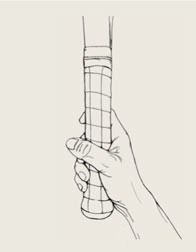
Index knuckle and heel pad on bevel 4
The Semi-Western grip has become a very popular option for baseline players as it is able to produce both topspin and power, which can be devastating if mastered correctly. That’s probably why the Semi-Western grip has become preferred for forehand over other tennis grips. The point of contact for balls will be between waist and shoulder-height.
Place your index knuckle and heel pad on bevel #4 for a Semi-Western grip.
Advantages:
- Provides both topspin and power
- More safety and control
- Allows for contact points for shots farther in front of you
Disadvantages:
- Difficult to hit low balls
- Harder to change from Semi-Western to the Continental grip for volleys
Western Grip
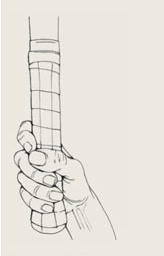
Index knuckle and heel pad on bevel 5
The Western grip is not used as often as the other tennis grips since it is harder to play with consistently, but offers the ability to apply extreme topspin to your shots.
For a Western grip, place your index knuckle and heel pad on bevel 5.
Advantages:
- Creates more topspin than any other type of tennis grip
- Balls often bounce high and fast
- Contact points are further out in front of you
Disadvantages:
- Very difficult to return low balls
- Harder to use on faster surfaces
- Harder to change to and from a Western grip
Double-Handed Backhand Grip
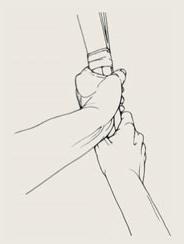
Index knuckle and heel pad of left hand on bevel 7. For the right hand, index knuckle on bevel 2 and heel pad on bevel 1.
The double-handed backhand grip is used often as it provides both stability and control. It is also easier to learn, which is why most beginners start learning backhands with two hands. The two-handed backhand relies largely on shoulder rotation and proper swing in order to produce power.
To achieve this grip, your index knuckle and heel pad of the left hand will rest on bevel 7, while for the right hand, the index knuckle will be on bevel 2 while the heel pad is on bevel 1.
Advantages:
- Easier to learn than a one-handed backhand
- Provides both stability and control
- Great for low shots
- Can produce a lot of power and topspin
Disadvantages:
- Takes more time to setup
- Limits a player’s reach, making wide shots harder
Conclusion:
- 2 — continental — hand slightly to the top but behind the racket
- 3 — eastern forehand grip — hand behind the racket
- 4 — semi western grip — hand slightly underneath the handle — good for top spin
- 5 — full western grip –hand compelitly underneath the handle
1 — eastern backhand, the nucles straight across the grip on bevel no 1
